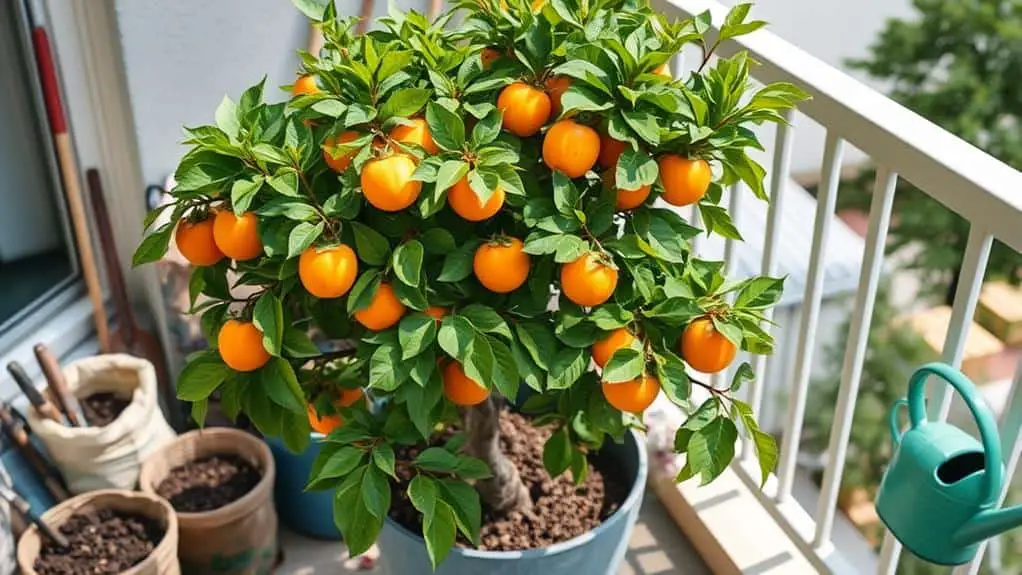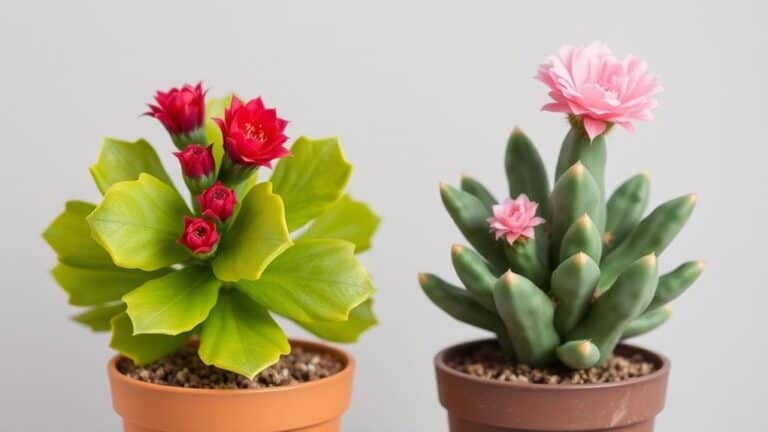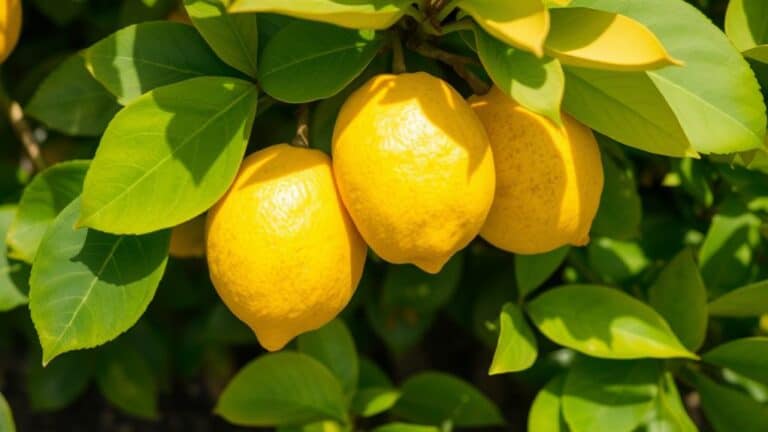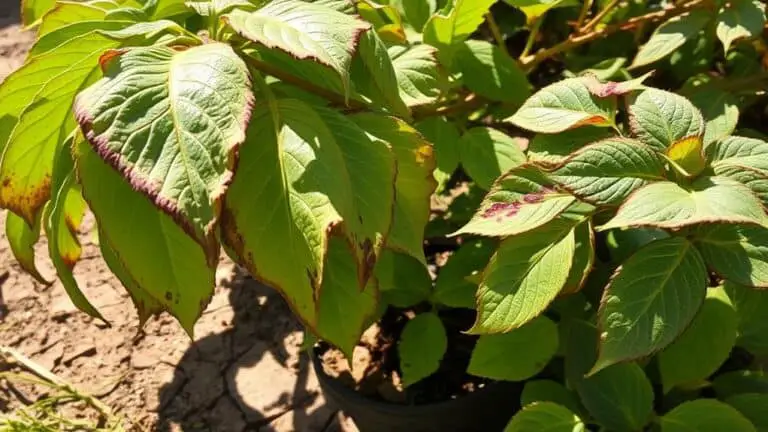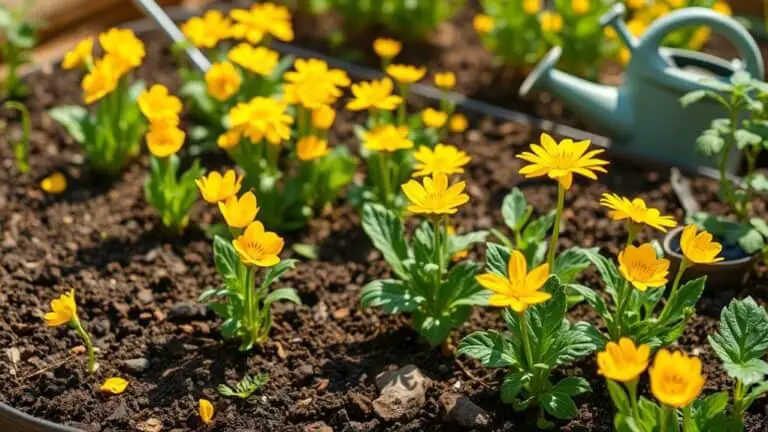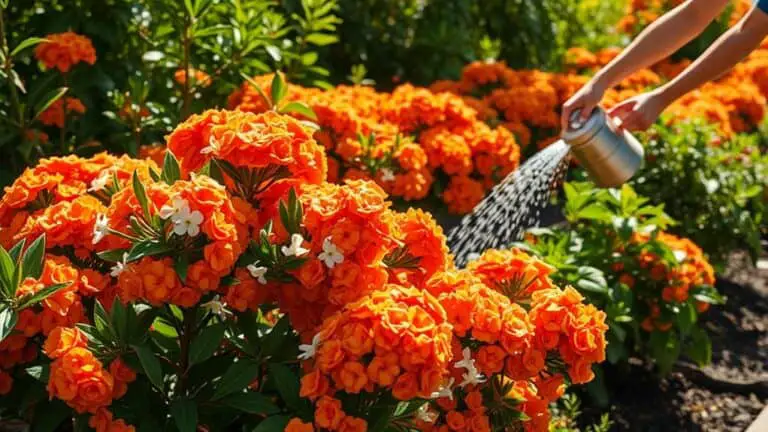How To Grow A Persimmon Tree In A Container
I've been experimenting with container gardening, and one of the more rewarding challenges has been growing a persimmon tree in a pot. To start, you need to pick the right variety, like the non-astringent Fuyu or a compact type such as Tam Kam. But that's just the beginning. The container size, soil mix, and placement all play vital roles. Now, what do you think is the most critical step after selecting the variety? Let's explore the essentials that'll help you nurture a healthy, fruit-bearing persimmon tree in a container.
Selecting the Right Variety
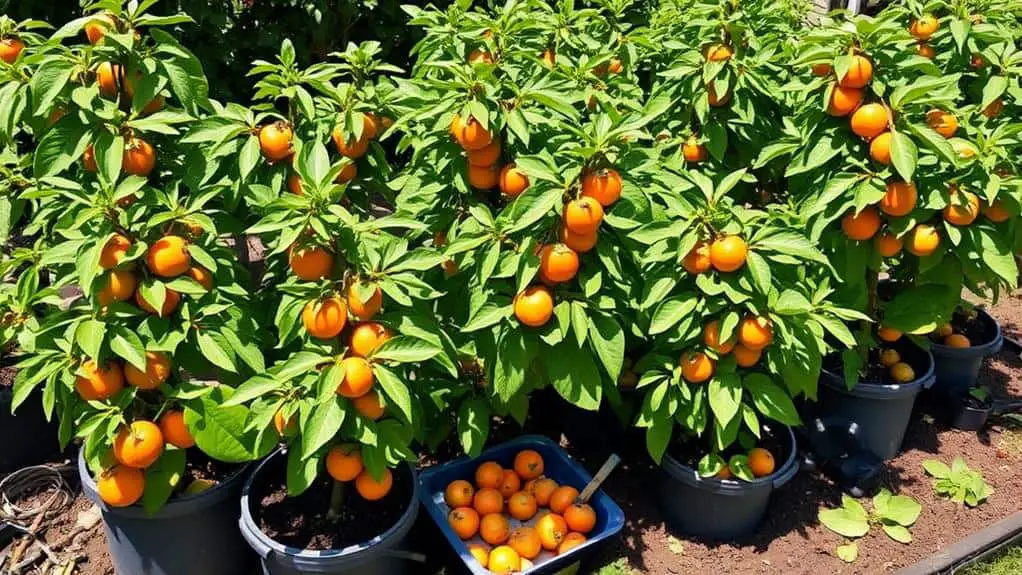
Choosing the right persimmon variety is essential for successful container gardening.
I recommend starting with the Fuyu Persimmon Tree, which produces delicious, non-astringent persimmons. This variety is well-suited for pots and has excellent fruit quality.
For limited spaces, consider compact cultivars like Tam Kam and Jiro. These trees stay manageable in size and are hardy.
If you're in a colder climate, American persimmons like Prok and Yates might be a good fit, but check their cold hardiness for your zone.
Pollination can improve fruit yield and flavor, so choose a self-pollinating variety or one that pairs well with another.
Knowing these details guarantees you pick the best tree for your container garden.
Choosing the Perfect Container
When it comes to finding the perfect container for your persimmon tree, size truly matters. You'll want a container that's at least 15-20 gallons. This guarantees your persimmon tree in containers has plenty of room for its roots to grow and thrive.
Make sure the container has multiple drainage holes to prevent waterlogging, which can lead to root rot.
I recommend using smart pots or air-pruning pots. These promote better aeration and encourage healthy root development.
Lightweight potting mixes, like Miracle-Gro Moisture Control Potting Mix, help with drainage and keep the soil from getting too dense.
Don't forget to check if the pot is easy to move. Pots with wheels or using a dolly can make repositioning your tree much easier.
Preparing the Soil Mix
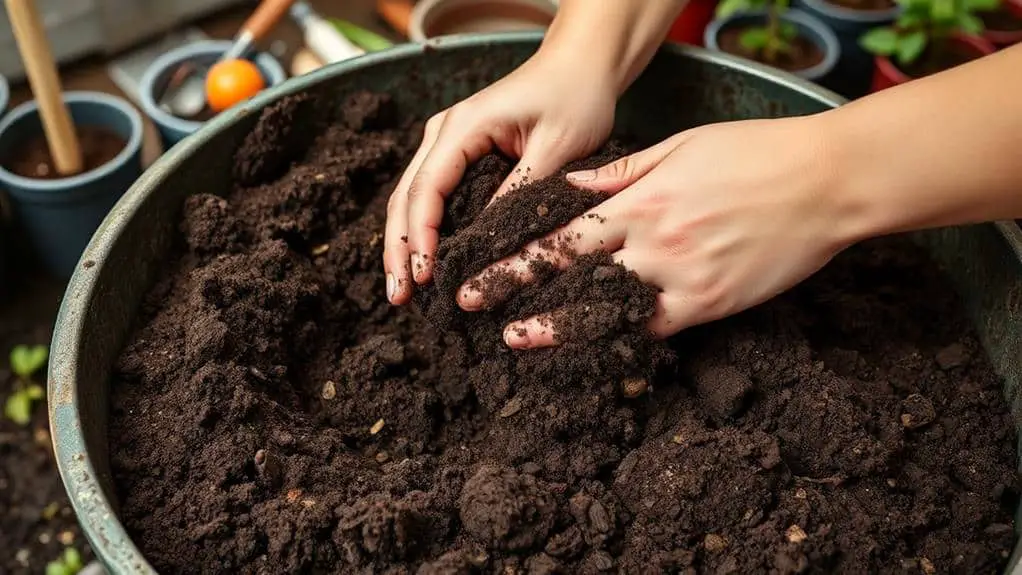
Creating the ideal soil mix for your persimmon tree is crucial for its overall health and growth. A well-draining mix will prevent waterlogging and promote strong root growth.
Here's how to prepare it:
- Combine peat, perlite, and compost for a nutrient-rich base.
- Confirm the soil pH is slightly acidic to neutral, between 6.0 and 7.0.
- Incorporate Scotts Osmocote® Compost Premium Soil Improver to enhance structure and moisture retention.
- Avoid heavy or compacted soil to prevent root rot.
- Refresh the soil by repotting every 2-3 years with fresh mix.
Planting Your Persimmon Tree
Now that you have your soil mix ready, let's move on to planting your persimmon tree.
First, grab a container that's at least 15-20 gallons with drainage holes. This size will give the root system enough space to grow. Fill the container with your well-draining potting mix, adding Scotts Osmocote® Compost for better soil quality.
Next, dig a hole twice as wide as the root ball but of the same depth. Loosen the soil at the bottom and mix in some slow-release fertilizer like Scotts Performance Naturals™.
Place your tree in the hole, firm the soil around the roots, and water thoroughly.
Positioning for Optimal Sunlight

Guaranteeing your persimmon tree thrives starts with finding the perfect spot for its container. For ideal growth, position the container where it will receive full sun for at least 6-8 hours daily. This is vital to promote healthy growth and fruiting.
Keep these tips in mind:
- Full sun: Verify the spot gets 6-8 hours of sunlight.
- Shelter from wind: Shield the container to prevent wind damage.
- Afternoon shade: In extreme heat, provide some shade to avoid sunburn.
- South-facing spot: In colder climates, place the container facing south for winter sunlight.
- Monitor sunlight: Regularly check and adjust the position to guarantee adequate light.
Watering and Moisture Control
Watering your persimmon tree properly is key to its health and growth.
I recommend setting up a consistent schedule to keep the soil evenly moist without overwatering.
Keep an eye on the soil's moisture by checking it regularly, and use efficient methods like drip irrigation to make sure your tree gets the right amount of water.
Consistent Watering Schedule
Maintaining a consistent watering schedule is essential for growing a healthy persimmon tree in a container. Consistent watering helps your potted persimmons thrive and supports good fruit production. Here are some key tips:
- Water thoroughly: Make sure water drains from the bottom of the container to hydrate the entire root system.
- Monitor frequently: Check soil moisture often, especially in hot, dry summer periods.
- Avoid dry soil: Don't let the soil dry out completely during peak growing season to prevent stress.
- Adjust based on conditions: Change your watering frequency depending on the pot size and weather.
- Prevent waterlogging: Keep soil moist but not waterlogged to avoid root rot.
Soil Moisture Monitoring
Keeping your persimmon tree properly hydrated begins with monitoring soil moisture levels. You must check the soil regularly to guarantee it stays consistently moist but not waterlogged.
Persimmons hate "wet feet," which can cause root rot. After planting, water the tree thoroughly to help the roots establish. During peak summer, check the soil daily to prevent it from drying out.
Use a light potting mix to promote drainage, avoiding heavy mixes that hold too much moisture. Adjust your watering frequency based on the container size and weather conditions. Hot, dry spells may require more frequent watering.
Efficient Irrigation Methods
Ensuring efficient irrigation for your container-grown persimmon tree is essential for its health and productivity. Consistent moisture is key, so check the soil daily, especially during hot, dry summer months.
Here are some tips:
- Use drip irrigation or soaker hoses to water thoroughly and reach the root zone.
- Make sure your container has multiple drainage holes to prevent root rot.
- Water thoroughly after planting to help the roots establish.
- Maintain moisture by watering when the top inch of soil feels dry.
- Adjust watering frequency based on temperature and humidity; larger pots might need less frequent watering.
Fertilization Tips
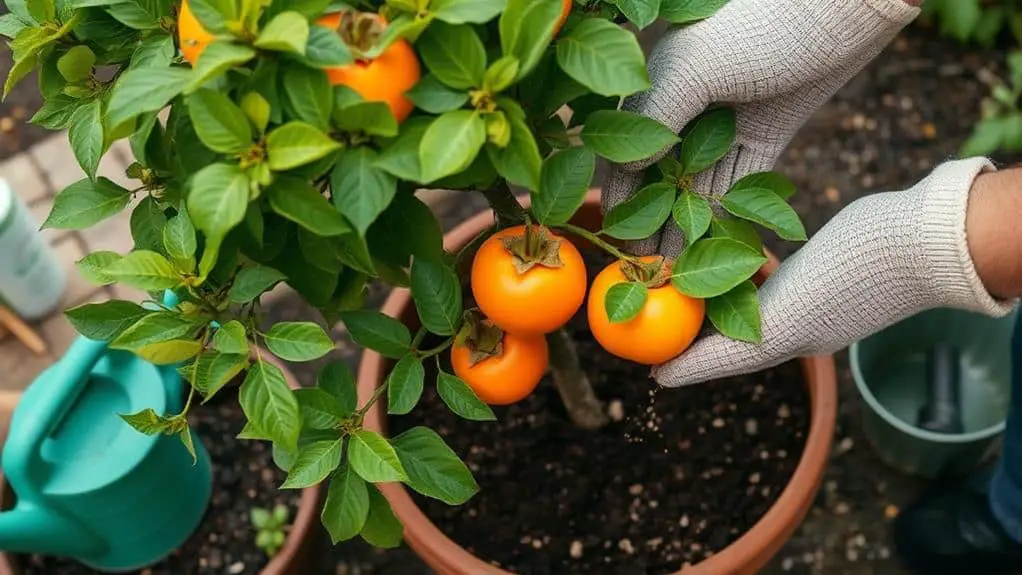
When it comes to fertilizing your persimmon tree, choosing the right organic fertilizer is key.
I recommend using Scotts Performance Naturals™ Citrus & Fruit Organic Based Fertilizer at the start of the growing season to give your tree the essential nutrients it needs.
Remember to fertilize every 6-8 weeks, but be careful not to overdo it to avoid root burn and poor fruiting.
Choosing Organic Fertilizers
To guarantee your persimmon tree gets the nutrients it needs, choosing the right organic fertilizer is vital.
I recommend using Scotts Performance Naturals™ Citrus & Fruit Organic Based Fertiliser for its balanced nutrients that support healthy fruit development.
To enhance soil structure and fertility, mix in Scotts Osmocote® Compost Premium Soil Improver.
Always follow the recommended rates to avoid over-fertilization and root burn.
Regularly monitoring soil moisture is essential, as persimmons thrive in well-draining soil with balanced organic matter.
Here are some tips to keep in mind:
- Use organic-based fertilizers.
- Follow the application rates on the label.
- Add soil improvers to the mix.
- Monitor soil moisture regularly.
- Guarantee well-draining soil.
Timing of Fertilization
After selecting the right organic fertilizers, it's important to know when to apply them for ideal growth and fruiting.
For potted persimmon trees, I recommend using a slow-release organic fertilizer in late winter or early spring. This timing supports new growth and fruit development.
Be careful not to over-fertilize; too much nitrogen can harm your fruit trees by causing root burn and poor fruiting. Always stick to the recommended rates on the fertilizer package.
A second round of fertilization in early summer provides additional nutrients during the active growing season.
Regularly monitor soil moisture and nutrient levels, adjusting fertilization as needed based on the tree's growth and health.
Incorporate compost into the potting mix during repotting every 2-3 years for enhanced soil fertility.
Pruning and Maintenance
Pruning and maintaining your persimmon tree in a container is vital for its health and productivity. I find that pruning in late winter or early spring helps shape the tree and promotes healthy growth by removing dead or diseased branches.
For container-grown trees, regular root pruning every 1-3 years invigorates the root system, which is significant.
Here's a handy list to guide you:
- Prune in late winter or early spring: Shape the tree and remove dead branches.
- Thin the fruit: Prevent overcrowding for larger, healthier fruit.
- Top prune: Maintain the tree's shape and encourage lateral growth.
- Root pruning: Do this every 1-3 years to keep the roots healthy.
- Create space for another tree: Self-pollinating varieties benefit from nearby trees.
Keeping these tips in mind will make certain your tree thrives!
Pest and Disease Management
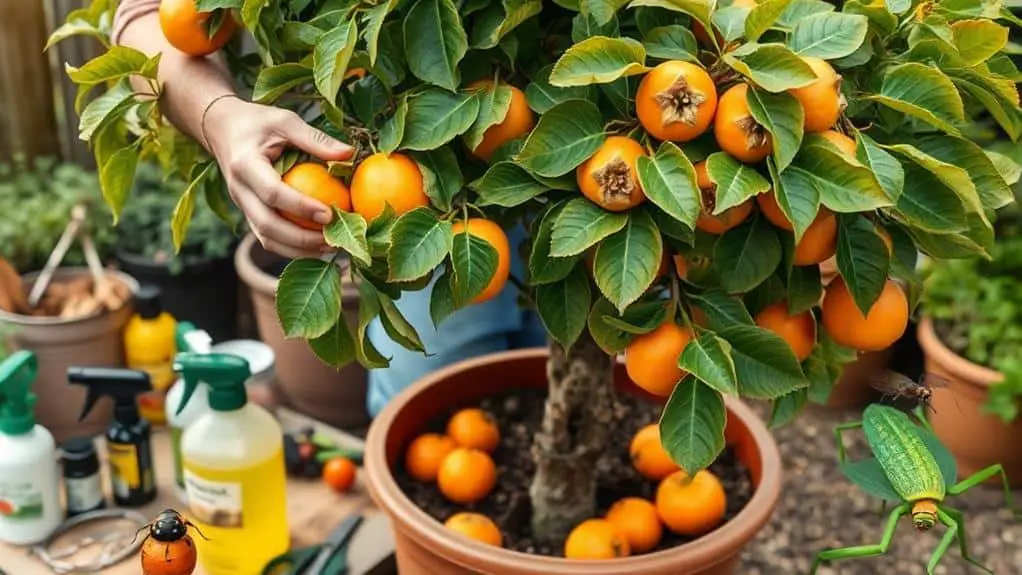
While maintaining your persimmon tree through pruning and care, it's equally important to be vigilant about pest and disease management.
Regularly inspect your tree for pests like aphids, spider mites, and scale. Treat infestations promptly with organic insecticidal soap or neem oil.
Prune crowded branches to maintain good air circulation, which helps prevent fungal diseases such as powdery mildew and leaf spot. Guarantee proper drainage in your container to avoid waterlogged soil, as excess moisture can lead to root rot.
Apply wildlife-safe crop protection netting to deter birds and pests. Monitor for signs of disease, like wilting leaves or black spots.
Remove any affected parts immediately using sterilized tools to prevent the disease from spreading.
Harvesting Your Persimmons
When it comes to harvesting your persimmons, timing is everything. You'll want to start checking your fruit from April to June. Look for a color change to signal ripeness.
Depending on whether your persimmons are astringent or non-astringent, your approach will vary:
- Astringent varieties: Wait until they soften to a jam-like texture.
- Non-astringent varieties: Harvest when the skin changes color, but the flesh is still firm.
Use secateurs to carefully cut the fruit, avoiding damage to the skin.
Regularly check for ripe fruit to prevent birds and pests from getting to them first.
Consider using wildlife-safe crop protection netting to safeguard your bounty.
Happy harvesting!
Frequently Asked Questions
Do Persimmons Grow Well in Pots?
Yes, persimmons grow well in pots. I recommend non-astringent persimmon varieties, like Fuyu. Make certain your container size is at least 15-20 gallons. Focus on soil requirements, and maintain consistent watering frequency for healthy growth.
How Many Years Does It Take for a Persimmon Tree to Bear Fruit?
It usually takes 5 to 6 years for a persimmon tree to start fruiting. Tree maintenance, container size, and climate requirements all play essential roles. Younger trees might fruit sooner with proper care and ideal conditions.
Do I Need Two Persimmon Trees to Get Fruit?
You don't need two persimmon trees for fruit if you choose self-pollinating varieties like Fuyu. For better fruit size and flavor, though, consider planting two. Remember, container tree care and pollination methods can affect fruiting age factors.
How Do You Plant a Potted Persimmon Tree?
When planting a potted persimmon tree, choose a large container, use high-quality potting soil, and guarantee full sunlight. Water regularly, keeping the soil moist but not soggy. Follow a consistent watering schedule for best growth.
Conclusion
Growing a persimmon tree in a container is totally doable, and I believe you can do it! Just remember to pick the right variety, use a good-sized pot with proper soil, and give your tree plenty of sunlight. Stay on top of watering, fertilizing, and pruning, and you'll be rewarded with delicious fruit. Don't worry if it takes a bit of time to get the hang of it—you're on the path to becoming a great gardener!

